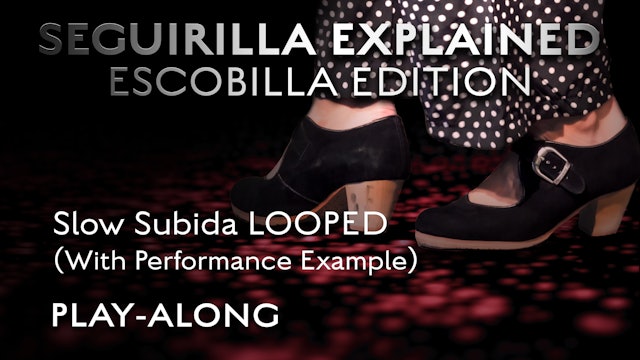Seguirilla Explained - Escobilla Edition
The Escobilla Edition is a very close look at one of the important aspects of accompanying the footwork section - the Escobilla - of a danced Seguirillas. In addition to being very useful for those who want to accompany dance, learning how to play the Escobilla is a great way to improve your compás and to get a fuller understanding of the Palo itself. Even if your focus is on playing solo guitar or accompanying Cante, any time you go a bit faster in Seguirillas or play to a strict pulse, your understanding of the Escobilla will inform that.
With dancer Estefania Narvaez - https://estefanianarvaez.com And Percussion by Chema Del Estad - https://chemadelestad.wordpress.com
-
Seguirilla Explained - Escobilla Edition Course Materials
12.3 MB
17 Page .pdf that goes with the Seguirilla Explained - Escobilla Edition course.
-
Seguirillas Explained - Escobilla Edition - INTRODUCTION
New Course Coming September 1st - Watch Intro Now. Welcome to Seguirillas Explained - Escobilla Edition, a course that features tutorials and Play-Alongs to teach you what you need to know to accompany the Escobilla section of a danced Seguirillas.
-
Starting With The Traditional Escobilla Falseta - TUTORIAL
We look at how to incorporate the traditional Escobilla falseta por Seguirillas and what to listen for in the dance to make sure you know where you are and where to start.
-
Transitioning Into The Falseta - Cierres and Llamadas - TUTORIAL
How to hear and play the Llamadas and Cierres that you'll hear at the beginnings and ends of your Escobillas.
-
Groove in Escobilla: Right-Hand Pattern & Chords - TUTORIAL
We look at right-hand patterns for staying in compás and grooving while accompanying the Escobilla por Seguirillas.
-
Going Faster: Accompanying a Subida - TUTORIAL
The Subida is when the dancer starts going faster, and in this video we look at how to hear that so that you're always in compás and we look at some right-hand patterns for going fast.
-
Other Falsetas You Can Use - TUTORIAL
Beyond the traditional falseta there are tons that will work nicely for accompanying the Escobilla. We look at a few, and at what makes them appropriate ones for the Escobilla.
-
Traditional Falseta: 100bpm Keeping Compás - TUTORIAL
A performance of various types of material you can use in an Escobilla, all played at a constant tempo of 100bpm. 100bpm is on the slow end of the range of tempos you might encounter, but a nice tempo for getting used to playing your Seguirillas in strict time.
-
Play-Along: 100bpm LOOPED - Constant Tempo- PLAY-ALONG
An unaccompanied loop of a Seguirillas Escobilla danced at a constant tempo of 100bpm. This is a great place to start practicing your Escobilla material, as the tempo is very manageable.
-
Escobilla Performance: 130bpm Traditional Falseta & Keeping Compás - PERFORMANCE
A performance of the traditional falseta and then simply keeping time for an Escobilla at a constant tempo of 130bpm.
-
Play-Along 130bpm LOOPED - Constant Tempo - PLAY-ALONG
An unaccompanied loop of a Seguirillas Escobilla danced at a constant tempo of 130bpm. If you feel comfortable playing your material at 100bpm, then this is the next step.
-
Traditional Falseta & Keeping Compás at 160 bpm - PERFORMANCE
Performance of the traditional Escobilla falseta and of simple compás variations to accompany a Seguirillas Escobilla at a constant tempo of 160bpm.
-
Play-Along: 160bpm LOOPED Constant Tempo - PLAY-ALONG
An unaccompanied loop of a Seguirillas Escobilla danced at a constant tempo of 160bpm. This is our fastest constant tempo loop, so be sure you're comfortable with your material at 130bpm before jumping in to this tempo.
-
Slow Subida Looped with Performance Example - PLAY-ALONG
A performance followed by a Play-Along loop of a Subida in an Escobilla por Seguirillas. This is the slower of our two Play-Along Subidas.
-
Faster Subida LOOPED (With Performance Example) - PLAY-ALONG
A performance followed by a Play-Along loop of a Subida in an Escobilla por Seguirillas. This is the faster of the two versions of the Subida that we have.

















